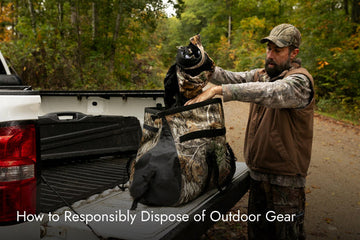Responsible Ways to Dispose of Outdoor Gear | Geckobrands

As outdoor enthusiasts, we cherish the beauty of nature, and it’s our responsibility to protect it. But what do you do when your trusty hiking boots wear out, your tent rips beyond repair, or your gear no longer suits your needs? Tossing it in the trash contributes to overflowing landfills and environmental harm. Instead, let’s explore sustainable ways to dispose of, reuse, and recycle outdoor gear responsibly.
This guide is here to help you navigate common dilemmas about old gear, with practical tips and real-life solutions that make sustainability approachable—and even a little fun.
Step-by-Step Guide to Disposing of Outdoor Gear Responsibly
1. Assess the Condition of Your Gear
Before deciding how to dispose of your outdoor gear, take a moment to assess its condition:
-
Still Usable? If the gear is in decent shape, someone else might be able to use it.
-
Repairable? Minor damage like torn fabric, broken zippers, or worn soles can often be fixed.
-
Beyond Repair? If the gear is truly unusable, recycling or proper disposal is your best option.
2. Repair and Repurpose Damaged Gear
-
DIY Repairs: Patch holes, replace zippers, or re-seal seams using repair kits.
-
Professional Repairs: Send items to brands or repair services specializing in outdoor gear.
-
Creative Repurposing: Turn old tents into ground tarps, use climbing ropes for crafts, or make tote bags from worn-out backpacks.
3. Donate Gear in Good Condition
If your gear is still functional but no longer serves you, donating it is a great option. Clean your gear thoroughly before donating to ensure it’s ready for its new owner.
4. Recycle Gear Beyond Repair
-
Clothing and Fabric Recycling: Look for textile recycling programs for torn clothing, backpacks, or tents.
-
Specialized Programs: Some brands offer take-back programs for used gear.
-
Metal Recycling: Aluminum tent poles or cookware can usually be recycled at local centers.
5. Sell or Trade Usable Gear
Selling or trading gear is an excellent way to give it a second life:
-
Use platforms like eBay, Facebook Marketplace, or GearTrade.
-
Join community swaps or consignment stores to trade gear with fellow enthusiasts.
-
Swapping gear at local gear swap stores.
6. Dispose of Gear Properly
For items that cannot be repaired, donated, or recycled:
-
Landfill as a Last Resort: Remove non-biodegradable parts to reduce environmental impact.
-
Hazardous Materials: Check local regulations for disposing of items like fuel canisters or waterproof coatings.
Why Responsible Gear Disposal Matters
Every piece of outdoor gear has an environmental footprint, from production to disposal. By repairing, donating, repurposing, or recycling, we can:
-
Reduce waste sent to landfills.
-
Conserve resources by extending the life of materials.
-
Support sustainable practices in the outdoor industry.
Reusing old or used gear. Using sleeping bags as car camping blankets.
FAQs for Outdoor Gear
1. Can I Recycle Old Hiking Boots?
Yes, but it depends on the materials. Leather boots can sometimes be recycled through textile programs, while rubber soles may require specialized recycling centers. If recycling isn’t available, consider donating boots in decent condition or repurposing them for gardening or light-duty tasks. Using used or worn-out boots and turning them into planters
2. What Should I Do with Broken Tents?
If repair isn’t an option, recycle the poles at a metal recycling center. Tent fabric can often be repurposed into tarps, tote bags, or other practical items. Textile recycling programs may accept the fabric if repurposing isn’t feasible.
3. Are There Gear Buyback Programs?
Certainly! Many companies offer buyback or trade-in programs. These initiatives allow customers to trade in used items for store credit. This approach ensures that the items are either reused or responsibly recycled, aligning with sustainable business practices.
4. Is Donating Better Than Recycling?
If the gear is still functional, donating is preferable. It helps others enjoy the outdoors while reducing waste. Recycling is the next best option for items that can’t be reused or repaired.
5. How Can I Repair My Outdoor Gear?
Several companies, like Patagonia Worn Wear, Rainy Pass Repair, and Gear Aid to name a few provide repair services for damaged outdoor gear, ensuring prolonged use of items like tents, sleeping bags, and jackets. For those who prefer DIY solutions, repair kits are available, and numerous online tutorials offer guidance on basic fixes, such as patching holes or replacing zippers. Using duct tape as a temporary emergency solution to fix tent tears.
6. Where Can I Donate Outdoor Gear?
You can donate gently used gear to:
-
Local Outdoor Clubs: Many hiking and camping groups accept donations.
-
Nonprofits: Goodwill, The Salvation Army, and local shelters distribute gear to those in need.
-
Gear Libraries: Community gear libraries make outdoor activities accessible by lending equipment.
Final thoughts
Disposing of outdoor gear responsibly doesn’t have to be complicated. By assessing your gear, donating, repairing, recycling, or selling it, you can keep it out of landfills and in use. Whether it’s giving your old backpack a second life or turning a torn jacket into a new project, small actions make a big difference. Let’s protect the outdoors we love by making thoughtful choices about our gear.

